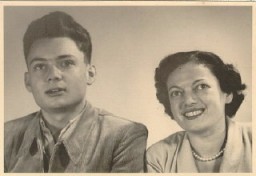You searched for: Survivors
<< Previous | Displaying results 101-125 of 456 for "Survivors" | Next >>
-
Norman Salsitz's daughter
PhotoNorman's daughter, Esther, at age one. April 1957. With the end of World War II and collapse of the Nazi regime, survivors of the Holocaust faced the daunting task of rebuilding their lives. With little in the way of financial resources and few, if any, surviving family members, most eventually emigrated from Europe to start their lives again. Between 1945 and 1952, more than 80,000 Holocaust survivors immigrated to the United States. Norman was one of them.
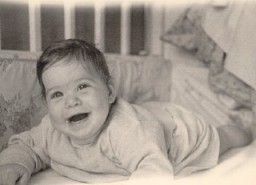
-
Norman Salsitz in the United States
PhotoNorman (with camera) in the United States. August 1948. With the end of World War II and collapse of the Nazi regime, survivors of the Holocaust faced the daunting task of rebuilding their lives. With little in the way of financial resources and few, if any, surviving family members, most eventually emigrated from Europe to start their lives again. Between 1945 and 1952, more than 80,000 Holocaust survivors immigrated to the United States. Norman was one of them.
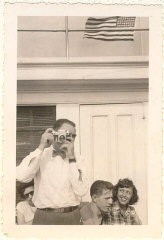
-
Norman Salsitz's grandchildren
PhotoNorman's grandchildren, Dustin, Aaron, and Michael. September 30, 1993. With the end of World War II and collapse of the Nazi regime, survivors of the Holocaust faced the daunting task of rebuilding their lives. With little in the way of financial resources and few, if any, surviving family members, most eventually emigrated from Europe to start their lives again. Between 1945 and 1952, more than 80,000 Holocaust survivors immigrated to the United States. Norman was one of them.
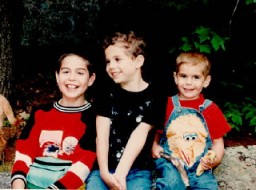
-
Norman Salsitz's grandchildren in 1997
PhotoNorman's grandchildren, Michael, Dustin, and Aaron in 1997. With the end of World War II and collapse of the Nazi regime, survivors of the Holocaust faced the daunting task of rebuilding their lives. With little in the way of financial resources and few, if any, surviving family members, most eventually emigrated from Europe to start their lives again. Between 1945 and 1952, more than 80,000 Holocaust survivors immigrated to the United States. Norman was one of them.
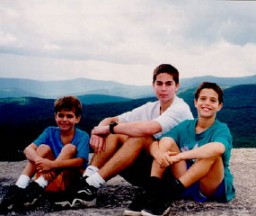
-
Thomas as a law student
PhotoThomas Buergenthal as a law student, 1959–60. With the end of World War II and collapse of the Nazi regime, survivors of the Holocaust faced the daunting task of rebuilding their lives. With little in the way of financial resources and few, if any, surviving family members, most eventually emigrated from Europe to start their lives again. Between 1945 and 1952, more than 80,000 Holocaust survivors immigrated to the United States. Thomas was one of them.
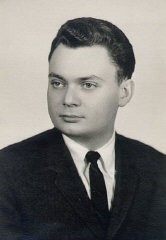
-
Nazi Hunting: Simon Wiesenthal
ArticleHolocaust survivor Simon Wiesenthal dedicated his life to raising public awareness of the need to hunt and prosecute Nazis who had evaded justice.
-
Lampertheim Displaced Persons Camp
ArticleAfter WWII, many Holocaust survivors, unable to return to their homes, lived in displaced persons camps in Germany, Austria, and Italy. Read about Lampertheim DP camp.

-
Lindenfels Displaced Persons Camp
ArticleAfter WWII, many Holocaust survivors, unable to return to their homes, lived in displaced persons camps in Germany, Austria, and Italy. Read about Lindenfels DP camp.
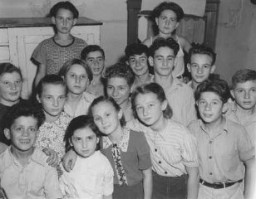
-
München Neu Freimann Displaced Persons Camp
ArticleAfter WWII, many Holocaust survivors, unable to return to their homes, lived in displaced persons camps in Germany, Austria, and Italy. Read about München Neu Freimann DP camp.
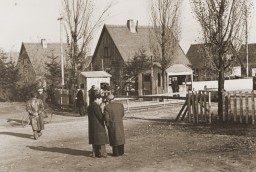
-
Thomas Buergenthal with one of his grandchildren
PhotoThomas with Eliza, one of his grandchildren. 1996. With the end of World War II and collapse of the Nazi regime, survivors of the Holocaust faced the daunting task of rebuilding their lives. With little in the way of financial resources and few, if any, surviving family members, most eventually emigrated from Europe to start their lives again. Between 1945 and 1952, more than 80,000 Holocaust survivors immigrated to the United States. Thomas was one of them.
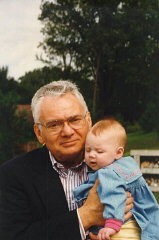
-
Norman Salsitz with his sister Rachel and brother David
PhotoThis 1925 photograph taken in Kolbuszowa, Poland, shows Norman Salsitz (at right) with his sister Rachel (left) and brother David (center). With the end of World War II and collapse of the Nazi regime, survivors of the Holocaust faced the daunting task of rebuilding their lives. With little in the way of financial resources and few, if any, surviving family members, most eventually emigrated from Europe to start their lives again. Between 1945 and 1952, more than 80,000 Holocaust survivors immigrated to…
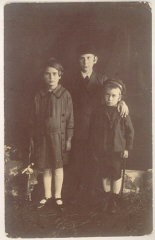
-
Norman Salsitz and Amalie Petranka shortly after they met
PhotoNorman Salsitz and Amalie Petranka shortly after they met (under their assumed identities of, respectively, Felicja Milaszewska and Tadeusz Zaleski). Krakow, Poland, March 15, 1945. With the end of World War II and collapse of the Nazi regime, survivors of the Holocaust faced the daunting task of rebuilding their lives. With little in the way of financial resources and few, if any, surviving family members, most eventually emigrated from Europe to start their lives again. Between 1945 and 1952, more than…

-
Amalie and Norman Salsitz, Brooklyn, New York, 1949
Photo1949 photograph of Amalie and Norman Salsitz in Brooklyn, New York, two years after they came to the United States. With the end of World War II and collapse of the Nazi regime, survivors of the Holocaust faced the daunting task of rebuilding their lives. With little in the way of financial resources and few, if any, surviving family members, most eventually emigrated from Europe to start their lives again. Between 1945 and 1952, more than 80,000 Holocaust survivors immigrated to the United…

-
Norman Salsitz's wife and daughter
PhotoNorman's daughter, Esther, at three weeks of age, with her mother, Amalie. September 1956. With the end of World War II and collapse of the Nazi regime, survivors of the Holocaust faced the daunting task of rebuilding their lives. With little in the way of financial resources and few, if any, surviving family members, most eventually emigrated from Europe to start their lives again. Between 1945 and 1952, more than 80,000 Holocaust survivors immigrated to the United States. Norman was one of them.
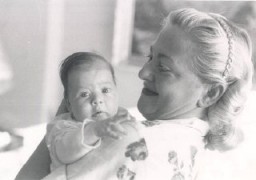
-
Amalie and Norman Salsitz go to Israel
PhotoAmalie and Norman Salsitz go to Israel to visit family members. Lod (Lydda), Israel, February 9, 1949. With the end of World War II and collapse of the Nazi regime, survivors of the Holocaust faced the daunting task of rebuilding their lives. With little in the way of financial resources and few, if any, surviving family members, most eventually emigrated from Europe to start their lives again. Between 1945 and 1952, more than 80,000 Holocaust survivors immigrated to the United States. Norman was one of…
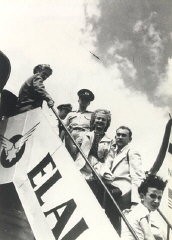
-
Photograph taken at Esther Salsitz's marriage
PhotoPhotograph taken at the marriage of Esther Salsitz and her fiance. Esther's parents, Norman and Amalie, stand at left and right (respectively). June 19, 1977. With the end of World War II and collapse of the Nazi regime, survivors of the Holocaust faced the daunting task of rebuilding their lives. With little in the way of financial resources and few, if any, surviving family members, most eventually emigrated from Europe to start their lives again. Between 1945 and 1952, more than 80,000 Holocaust…

-
Norman and Amalie Salsitz with their first grandchild
PhotoNorman and Amalie Salsitz with their first grandchild, Dustin. March 11, 1983. With the end of World War II and collapse of the Nazi regime, survivors of the Holocaust faced the daunting task of rebuilding their lives. With little in the way of financial resources and few, if any, surviving family members, most eventually emigrated from Europe to start their lives again. Between 1945 and 1952, more than 80,000 Holocaust survivors immigrated to the United States. Norman was one of them.
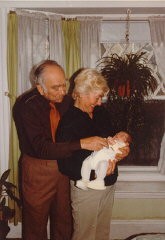
-
Amalie and Norman Salsitz with a copy of their book
PhotoJune 6, 1991, photograph showing Amalie and Norman Salsitz with a copy of their book, Against All Odds. With the end of World War II and collapse of the Nazi regime, survivors of the Holocaust faced the daunting task of rebuilding their lives. With little in the way of financial resources and few, if any, surviving family members, most eventually emigrated from Europe to start their lives again. Between 1945 and 1952, more than 80,000 Holocaust survivors immigrated to the United States. Norman was one of…
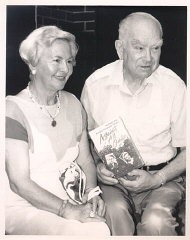
-
Norman Salsitz holds a photograph of himself and Amalie
PhotoNorman Salsitz holds a photograph of himself and Amalie from 1945. 2004. With the end of World War II and collapse of the Nazi regime, survivors of the Holocaust faced the daunting task of rebuilding their lives. With little in the way of financial resources and few, if any, surviving family members, most eventually emigrated from Europe to start their lives again. Between 1945 and 1952, more than 80,000 Holocaust survivors immigrated to the United States. Norman was one of them.
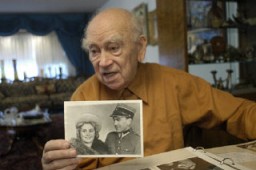
-
Norman Salsitz holds a photograph of his wife and daughter
PhotoNorman Salsitz holds a photograph of his wife, Amalie, and daughter, Esther. 2004. With the end of World War II and collapse of the Nazi regime, survivors of the Holocaust faced the daunting task of rebuilding their lives. With little in the way of financial resources and few, if any, surviving family members, most eventually emigrated from Europe to start their lives again. Between 1945 and 1952, more than 80,000 Holocaust survivors immigrated to the United States. Norman was one of them.
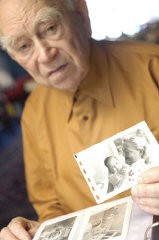
-
Norman Salsitz looking through his photographs
PhotoNorman Salsitz looks through his prewar family photographs. 2004. With the end of World War II and collapse of the Nazi regime, survivors of the Holocaust faced the daunting task of rebuilding their lives. With little in the way of financial resources and few, if any, surviving family members, most eventually emigrated from Europe to start their lives again. Between 1945 and 1952, more than 80,000 Holocaust survivors immigrated to the United States. Norman was one of them.

-
Thomas's parents, Mundek and Gerda
PhotoThomas Buergenthal's parents, Mundek and Gerda (b. 1912). Czechoslovakia, 1933 or 1934. With the end of World War II and collapse of the Nazi regime, survivors of the Holocaust faced the daunting task of rebuilding their lives. With little in the way of financial resources and few, if any, surviving family members, most eventually emigrated from Europe to start their lives again. Between 1945 and 1952, more than 80,000 Holocaust survivors immigrated to the United States. Thomas was one of them.

-
Three-year-old Thomas during a stay at a hotel in Czechoslovakia
PhotoThree-year-old Thomas Buergenthal during a stay at a hotel in Czechoslovakia, 1937. With the end of World War II and collapse of the Nazi regime, survivors of the Holocaust faced the daunting task of rebuilding their lives. With little in the way of financial resources and few, if any, surviving family members, most eventually emigrated from Europe to start their lives again. Between 1945 and 1952, more than 80,000 Holocaust survivors immigrated to the United States. Thomas was one of them.
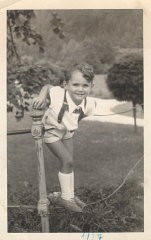
-
Three-year-old Thomas Buergenthal with his parents
PhotoThree-year-old Thomas Buergenthal with his parents, Mundek and Gerda. Czechoslovakia, June 1937. With the end of World War II and collapse of the Nazi regime, survivors of the Holocaust faced the daunting task of rebuilding their lives. With little in the way of financial resources and few, if any, surviving family members, most eventually emigrated from Europe to start their lives again. Between 1945 and 1952, more than 80,000 Holocaust survivors immigrated to the United States. Thomas was one of them.
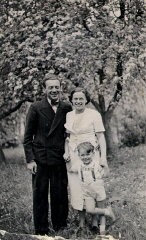
-
Thomas Buergenthal with his mother, Gerda, in Goettingen
PhotoThomas Buergenthal with his mother, Gerda, in Goettingen, Germany, 1950. With the end of World War II and collapse of the Nazi regime, survivors of the Holocaust faced the daunting task of rebuilding their lives. With little in the way of financial resources and few, if any, surviving family members, most eventually emigrated from Europe to start their lives again. Between 1945 and 1952, more than 80,000 Holocaust survivors immigrated to the United States. Thomas was one of them.
